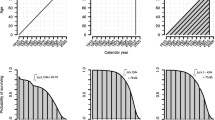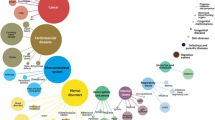Abstract
Given that chronic diseases account for 88% of all deaths in Canada, robust surveillance and monitoring systems are essential for supporting implementation of health promotion and chronic disease prevention policies. Canada has a long tradition of monitoring premature mortality expressed as potential years of life lost (PYLL), dating back to the seminal work by Romeder and McWhinnie in the late 1970s, who pioneered the use of PYLL as a tool in health planning and decision-making. The utility of PYLL for monitoring progress was expanded in the 1990s through the national comparable Health Indicators Initiative, following which PYLL has been monitored for several decades nationally, provincially, regionally and locally as part of health systems’ performance measurement. Yet the potential for using PYLL in health promotion and chronic disease prevention has not been maximized. Linking PYLL with public health programs and initiatives aimed at health promotion and chronic disease prevention, introduced starting in the 1990s, would inform whether these efforts are making progress in addressing the burden of premature mortality from chronic diseases. Promoting the use of PYLL due to chronic diseases would contribute toward providing a more complete picture of chronic diseases in Canada.
Résumé
Étant donné que les maladies chroniques sont à l’origine de 88% des décès au Canada, il est essentiel d’avoir des systèmes de surveillance et de contrôle robustes pour appuyer la mise en œuvre des politiques de promotion de la santé et de prévention des maladies chroniques. Le Canada a une longue tradition de surveillance de la mortalité prématurée, exprimée en années potentielles de vie perdues (APVP); cette tradition remonte aux travaux phares de Romeder et McWhinnie qui, à la fin des années 1970, ont été les pionniers de l’utilisation des APVP comme outil de planification sanitaire et de prise de décision. L’utilité des APVP pour faire le suivi des progrès réalisés s’est accrue dans les années 1 990 avec l’initiative nationale des Indicateurs comparables de la santé, depuis laquelle on suit les APVP au pays à l’échelle provinciale, régionale et locale lorsqu’on mesure le rendement des systèmes de santé. Pourtant, les possibilités d’utilisation des APVP pour la promotion de la santé et la prévention des maladies chroniques ne sont pas pleinement exploitées. Le maillage des APVP avec des programmes et initiatives de santé publique introduits dans les années 1990 pour promouvoir la santé et prévenir les maladies chroniques permettrait de savoir si ces efforts progressent vers l’allégement du fardeau de la mortalité prématurée due aux maladies chroniques. Promouvoir l’utilisation des APVP en raison des maladies chroniques contribuerait à dessiner un portrait plus détaillé des maladies chroniques au Canada.
Similar content being viewed by others
References
World Health Organization. Global Action Plan for the Prevention and Control of Noncommunicable Diseases 2013–2020. Geneva: World Health Organization, 2013.
World Health Organization. Noncommunicable Diseases Global Monitoring Framework. Geneva: World Health Organization, 2013. Available at: http://www.who.int/nmh/global_monitoring_framework/2013-11-06-who-dc-c268-whp-gap-ncds-techdoc-def3.pdf?ua=1 (Accessed July 6, 2015).
The Money Value of Man. 1930.
Dempsey M. Decline in tuberculosis: The death rate fails to tell the entire story. Am Rev Tuberc 1947;86:157.
Dickinson FG, Welker EL. What is the leading cause of death? AMA Bulletin 1948;64:1–25.
Romeder JM, McWhinnie JR. Potential years of life lost between ages 1 and 70: An indicator of premature mortality for health planning. Int J Epidemiol 1977;6(2):143–51. PMID: 892979. doi: 10.1093/ije/6.2.143.
Wigle DT, Mao Y, Semenciw R, McCann C, Davies JW. Premature deaths in Canada: Impact, trends and opportunities for prevention. Can J Public Health 1990;81(5):376–81. PMID: 2253155.
World Health Organization. The Ottawa Charter for Health Promotion. Geneva, Switzerland: WHO, 1986. Available at: http://www.euro.who.int/_data/assets/pdf_file/0004/129532/Ottawa_Charter.pdf?ua=1 (Accessed August 6, 2015).
Epp J. Achieving Health for All: A Framework for Health Promotion. Ottawa, ON: Health and Welfare Canada. 1986. Available at: http://www.hc-sc.gc.ca/hcs-sss/pubs/system-regime/1986-frame-plan-promotion/index-eng.php.
Canadian Institute of Health Information. The Health Indicators Project: The Next 5 Years. Report from the Second Consensus Conference on Population Health Indicators. Ottawa, ON: CIHI, 2005.
Shield KD, Taylor B, Kehoe T, Patra J, Rehm J. Mortality and potential years of life lost attributable to alcohol consumption in Canada in 2005. BMC Public Health 2012;12:91. PMID: 22293064. doi: 10.1186/1471-2458-12-91.
Tjepkema M, Wilkins R, Senécal S, Guimond E, Penney C. Potential years of life lost at ages 25 to 74 among Métis and non-Status Indians, 1991 to 2001. Health Rep 2011;22(1):1–11. PMID: 21510588.
Beaglehole R, Bonita R. Public Health at the Crossroads: Achievements and Prospects, 2nd ed. Cambridge: Cambridge University Press, 2004; 303 pp., ISBN 0-521-54047-X.
Gouda HN, Powles JW. The science of epidemiology and the methods needed for public health assessments: A review of epidemiology textbooks. BMC PublicHealth 2014;14:139. PMID: 24507570. doi: 10.1186/1471-2458-14-139.
Stein C, Kuchenmuller T, Hendrickx S, Pruss-Ustun A, Wolfson L, Engels D, et al. The global burden of disease assessments–WHO is responsible? PLoS Negl Trop Dis 2007;1(3):e161. PMID: 18160984. doi: 10.1371/journal.pntd.0000161.
Devleesschauwer B, Havelaar AH, Maertens de Noordhout C, Haagsma JA, Praet N, Dorny P, et al. Calculating disability-adjusted life years to quantify burden of disease. Int J Public Health 2014;59(3):565–69. PMID: 24752429. doi: 10.1007/s00038-014-0552-z.
Voigt K, King NB. Disability weights in the global burden of disease 2010 study: Two steps forward, one step back? Bull World Health Organ 2014;92(3):226–28. PMID: 24700983. doi: 10.2471/BLT.13.126227.
Polinder S, Haagsma JA, Stein C, Havelaar AH. Systematic review of general burden of disease studies using disability-adjusted life years. Popul Health Metr 2012;10(1):21. PMID: 23113929. doi: 10.1186/1478-7954-10-21.
Author information
Authors and Affiliations
Corresponding author
Additional information
Acknowledgements: KM holds a Career Development Award in Prevention Research funded by the Canadian Cancer Society (grant #702936). All interpretations and opinions in this commentary are those of the authors.
Conflict of Interest: None to declare.
Rights and permissions
About this article
Cite this article
Maximova, K., Rozen, S., Springett, J. et al. The use of potential years of life lost for monitoring premature mortality from chronic diseases: Canadian perspectives. Can J Public Health 107, e202–e204 (2016). https://doi.org/10.17269/cjph.107.5261
Received:
Accepted:
Published:
Issue Date:
DOI: https://doi.org/10.17269/cjph.107.5261




